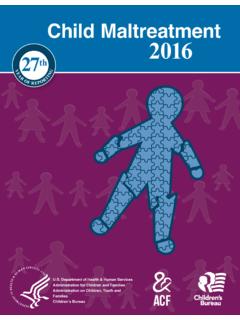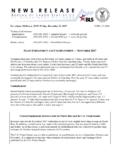Transcription of THE 2016 STATE OF WOMEN-OWNED BUSINESSES REPORT
1 THE 2016 STATE OF WOMEN-OWNED BUSINESSES REPORTC ommissioned by American Express OPEN A Summary of Important Trends, 2007- 2016 The STATE of WOMEN-OWNED BUSINESSES , 20162 This publication marks our sixth annual exploration and analysis of the STATE of WOMEN-OWNED BUSINESSES in the United states . Our aim is to provide stakeholders in the women s enterprise development community policy makers, entrepreneurial support organizations, suppliers and customers, and women business owners themselves with information and intelligence that can inform their efforts. American Express OPEN is proud to build upon the growing interest and commentary generated by our previous estimates contained in this REPORT are enhanced and strengthened by the publication, in late 2015, of the most recent (2012) Survey of Business Owners data from the Census Bureau, as well as from the most recent Gross Domestic Product estimates (as of January 2016 ) at the national, STATE , city, and industry levels.
2 Unlike previous reports, which analyzed longer-term trends between 1997 and the year of the REPORT , this REPORT focuses on trends that have largely taken place since the 2007-2009 recession focusing on changes that have occurred between 2007 and 2016 . Each of our annual reports has built upon the information investigated in the previous year. In our first REPORT we looked at trends among all WOMEN-OWNED firms by STATE , industry and revenue and employment size class. In our 2012 REPORT , we added analysis of trends in the top 25 metropolitan areas. In 2013, we added an analysis of trends among firms owned by women of color. In 2014, we added the concept of combined economic clout looking not only at growth in the number of firms but growth in employment and revenues as well. In 2015, we took a special look at pre-recession versus post-recession growth, to ascertain where WOMEN-OWNED firms had recovered from the effects of the recession and where growth was still year s REPORT in addition to focusing on more recent, largely post-recession, trends expands our geographic analysis to include a look at trends in the top 50 metropolitan areas (expanded from 25), and adds to our analysis of trends among firms owned by women of color by investigating the industry composition of minority WOMEN-OWNED firms.
3 It is our hope that this body of work not only provides useful intelligence to supporters of women s enterprise development, but provokes debate and discussion about how best to encourage WOMEN-OWNED firms to move up the size continuum, shines a spotlight on the phenomenal growth in multicultural WOMEN-OWNED enterprises, and highlights areas where policy and program action can be better targeted to help even more women achieve their entrepreneurial STATE of WOMEN-OWNED BUSINESSES , 20163 The number and economic contributions of WOMEN-OWNED firms continue to rise at rates higher than the national average with even stronger business formation rates seen since the of 2016 , it is estimated that there are now million (11,313,900) WOMEN-OWNED BUSINESSES in the United states , employing nearly 9 million people (8,976,100) and generating over $ trillion ($1,622,763,800,000) in revenues.
4 Between 2007 and 2016 , the number of WOMEN-OWNED firms increased by 45%, compared to just a 9% increase among all BUSINESSES . Therefore, over the past nine years, the number of WOMEN-OWNED firms has grown at a rate fully five times faster than the national average. Comparative employment growth is even stronger. Employment in WOMEN-OWNED BUSINESSES has increased by 18% since the recession, while among all BUSINESSES employment has declined 1% since 2007. Business revenues among WOMEN-OWNED firms have increased by 35% since 2007, compared to 27% among all firms thus at a rate that is 30% higher than the national average. women are now the majority owners of 38% of the country s BUSINESSES , up from 29% in 2007. These firms employ 8% of the nation s private sector workforce up from 6% nine years ago and contribute 4% of the nation s business revenues, a share that has not changed over the past 20 STATE OF WOMEN-OWNED BUSINESSES IN 2016 : SUMMARY OF KEY TRENDSNATIONAL TRENDSThe STATE of WOMEN-OWNED BUSINESSES , 20164 Where along the business size spectrum is the strongest economic growth coming from post-recession?
5 Among all BUSINESSES , only the very largest firms are growing. WOMEN-OWNED BUSINESSES , however, are growing all along the spectrum most particularly among those employing between 50 and 99 of most remarked-upon economic trends in the wake of the 2007-09 recession has been the lack of employment growth. According to the Bureau of Labor Statistics, there were 150 million employed persons as of February 2016 , up just from February 2007. Bucking that tepid growth trend is employment in WOMEN-OWNED firms, which according to this REPORT is up 18% since 2007 compared to a 1% decline among all Where is this employment growth coming from? The strongest employment growth among WOMEN-OWNED firms is seen among firms employing between 50 and 99 workers. These firms have spearheaded a 27% increase in employment since 2007, while both smaller and larger WOMEN-OWNED firms have seen positive employment gains as well.
6 In comparison, the only positive employment growth seen among all firms by employment size class has been among firms with 100 or more , revenue growth among all BUSINESSES (27% overall) is strongest among 500+ employee firms, where revenues have increased by 34% since 2007. Revenue growth among WOMEN-OWNED firms (35% overall) is again highest among WOMEN-OWNED firms with 50 to 99 employees (up 49%), followed by non-employer WOMEN-OWNED firms (whose revenues increased by 44%).NUMBER OF NET NEW WOMEN-OWNED FIRMS 2 Business creation activity varies over time. As reported in the 2015 STATE of WOMEN-OWNED BUSINESSES REPORT , between 1997 and 2015 there were an average of 608 net new WOMEN-OWNED BUSINESSES started each day, including a rate of 714 net new WOMEN-OWNED firms in the years leading up to the recent recession (2002-2007). Now, with new 2012 Census data available, we can see that business formation activity has picked up significantly among women .
7 Since 2007 there have been 1,072 net new WOMEN-OWNED firms started each day including 1,143 per day over the 2007 to 2012 period and a slightly lower 983 per day over the 2012 to 2016 period. All told, between 2007 and 2016 , there was an increase of million WOMEN-OWNED firms. Fully 78% of these net new WOMEN-OWNED firms (nearly million) are firms owned by women of color an average of 842 net new minority WOMEN-OWNED firms were launched each day over the past nine years. Among those 842 net new minority- owned firms per day since 2007 were 327 Latina- owned firms, 311 African American WOMEN-OWNED firms, 122 Asian American WOMEN-OWNED firms, 17 Native American/Alaska Native WOMEN-OWNED firms, and 5 Native Hawaiian/Pacific Islander WOMEN-OWNED The difference between the 1% decline among all private sector firms and the increase in total employment derives from the fact that the population of all private sector firms excludes government, public educational institutions, agriculture and the military.
8 2. Net New takes into account the number of firm births minus firm deaths or changes in ownership resulting in the loss of woman- owned STATE of WOMEN-OWNED BUSINESSES , 20165 One of the most remarkable trends over the past decade has been the phenomenal growth in the number of firms owned by women of of the most troubling economic trends in the wake of the 2007-09 recession has been the general lack of business formation, and the resulting lack of job growth. Economy-wide, the number of BUSINESSES has grown just 9% since 2007. However, this trend has not been followed among WOMEN-OWNED BUSINESSES . Their numbers have risen by 45% over the past nine years meaning that the rate of growth in the number of WOMEN-OWNED firms is fully five times the national average. And this has most especially not been the case among firms owned by women of color their numbers have more than doubled since 2007, increasing by 126%.
9 In fact, there are nearly million more firms owned by women of color now than in 2007, among an overall increase of million in the number of WOMEN-OWNED firms. This means that nearly eight out of every 10 (79%) net new WOMEN-OWNED firms launched since 2007 has been started by a woman of in 2002, there were fewer than 1 million firms owned by women of color, comprising just 14% of WOMEN-OWNED firms. In 2007, million minority WOMEN-OWNED firms accounted for 28% of all women -TRENDS IN ETHNIC DIVERSITY owned BUSINESSES . Now, as of 2016 , it is estimated that there are nearly 5 million minority WOMEN-OWNED firms (4,992,200), comprising fully 44% of WOMEN-OWNED firms. Collectively, minority WOMEN-OWNED firms employ 2 million workers and generate $344 billion in revenues. As of 2016 , there are an estimated million African American WOMEN-OWNED firms, employing 376,500 workers and generating $ billion in revenues.
10 Between 2007 and 2016 , the number of African American WOMEN-OWNED firms increased by 112% - more than doubling in number and far out shadowing the overall 45% increase among all WOMEN-OWNED firms. African American WOMEN-OWNED firms constitute a 61% majority of African American- owned of 2016 , there are just under million Latina- owned firms, employing 550,400 workers and generating $97 billion in revenues. Between 2007 and 2016 , the number of Latina- owned firms increased by 137% - the highest increase seen among minority WOMEN-OWNED firms. Latina- owned firms comprise 46% of all Latino- owned firms. As of 2016 , there are an estimated 922,700 Asian American WOMEN-OWNED firms, employing 964,900 workers and generating $ billion in revenues. Between 2007 and 2016 , the number of Asian American WOMEN-OWNED firms increased by 76%. Asian American WOMEN-OWNED firms comprise 41% of all Asian American- owned firms.





